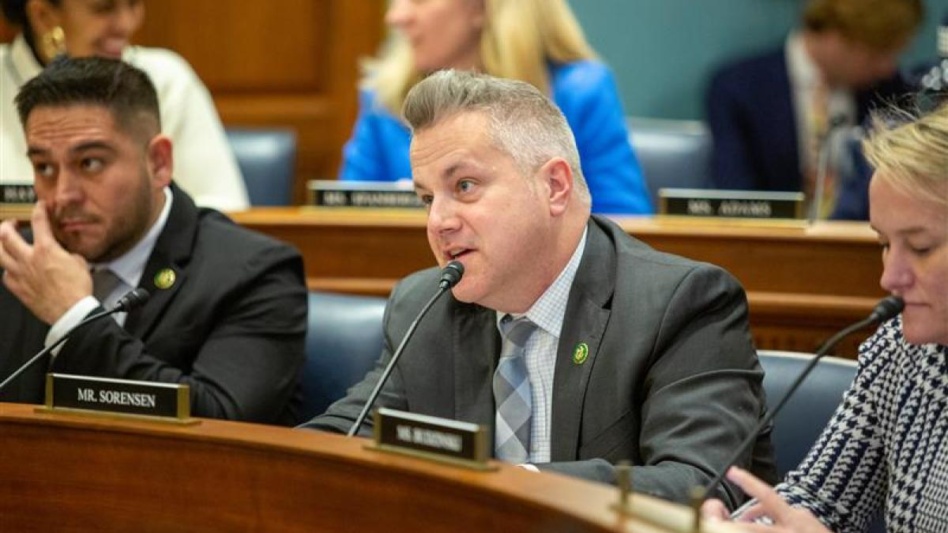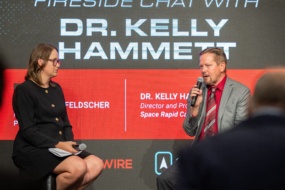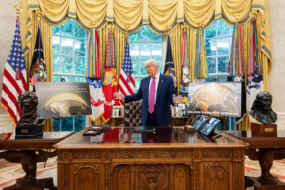A space leader on Capitol Hill is looking at how to eliminate gaps between the agencies that oversee human spaceflight over concerns about maintaining the highest safety standards.
Rep. Eric Sorensen (D-IL), the ranking member of the House space subcommittee, pointed out the multitude of groups that have a hand in regulating spaceflight, from the FAA to the FCC to the Commerce Department to the DoD. He said it’s something he wants to address in the NASA reauthorization bill, which Congress is in the midst of considering.
“There are so many different agencies that require collaboration, and at each one of these intersection points, I’m worried that there is a crack in safety,” Sorensen told Payload. “Those are some of the initial things we’ll have to solve as commercial spaceflight takes center stage.”
Go boldly: Despite these safety concerns, Sorensen, who had a toy space shuttle hanging from his ceiling as a kid, said he would have no hesitation about going into space if he ever got the opportunity.
“We have an astronaut in the Senate. We need to have an astronaut in the House. I’ll do it,” he said.
Sorensen 101: Sorensen is a former TV meteorologist from Illinois who was elected in November to his first term in the House. In a Q&A with Payload, he talked about his priorities as ranking member of the House space subcommittee, how space helps talk about climate change, and when he predicts the first person will walk on Mars.
This transcript has been edited for length and clarity.
What are your top space priorities for 2024, your second year in Congress and serving as ranking member of the House Space Subcommittee?
We’ve got to focus on innovation because innovation is really going to set the pace for us getting back to land on the lunar surface. Our pace of innovation is going to determine the timeframe that we put a human on Mars. My role right now is to ensure that our federal agencies have the resources and the workforce.
For me, as a meteorologist, I want to continue to inspire us to invest in what we’re doing. For NASA, that means as we continue work from the CHIPS and Science Act to make sure we’re utilizing everything from that law, and finding out what is the next big piece of legislation that we’re going to need.
There’s no boundary to space. We’ve got to make sure we’re focused on innovation, but also keeping our eyes set on safety, sustainability, and developing partnerships.
What does that big future space bill look like?
When we start looking at commercial spaceflight, there are a lot of government agencies that have to work together from the FAA to the FCC to the Commerce Department to DoD. There are so many different agencies that require collaboration, and at each one of these intersection points, I’m worried that there is a crack in safety. Those are some of the initial things we’ll have to solve as commercial spaceflight takes center stage. The NASA reauthorization bill will be an opportunity to drive this policy forward.
How do you see the role of space in both studying and fighting climate change?
There is a tremendous opportunity, when we look at the remote sensing ability that we have today that we didn’t even have when I was in college. The ability that we have to look into our own atmosphere from above thanks to the advancements of science and those that came to Congress ahead of me that said we need to fund NASA is an incredible tool that we can use not only to identify the changing climate, but also how we’re going to adapt to what global climate change is going to give us.
One of the biggest things that we need to focus on is really the communication of what is happening. As the local meteorologist, I was a trusted neighbor to my community because I could tell them, here’s what’s happening, here’s how it impacts your life, and I never told anyone they were doing anything wrong. We have to allow people to have the understanding of why we need to make good decisions, then as more people understand their place in how our climate works, they’re going to make better decisions.
I was grateful about a month ago to visit NASA’s Earth Information Center and see the place where the people in my district can walk through the door and learn about climate science. They get the visual tools and space based information to help them make good decisions
Does the space industry need to be more mindful of its own emissions from launch and manufacturing?
I think that’s up to all of us, public and private. We have a responsibility to be stewards of the environment that we live, work, and play in. We’ve gotta reduce emissions, especially from fossil fuels. We know that. And we have to budget as we go forward to make sure that we’re able to meet our climate goals.
I’m so interested in having us understand and see more of the interactions between our emissions, especially within the troposphere, but also as we look at it from above. How does this open up our understanding of what’s going on? For example, rocket launches and disintegration of satellites and some of the more harmful gasses that end up in the upper layers of our atmosphere, I think we’d be remiss if we’re not studying those today.
Tell me a little about the space industry and broader enthusiasm for space in Illinois.
In this district of northwestern Illinois, we have such a history of space. It goes back to the company that my dad worked for. My dad was an aerospace engineer. Before he retired, he worked at Hamilton Sundstrand. I was pretty proud of my dad, because he was working on the space shuttle program. As a kid, I had a space shuttle that I hooked up to my ceiling. I asked my mom for thread and a push pin, and thought I’d get in trouble for putting a push pin in my ceiling.
In 1986, being in that classroom when Challenger exploded, I remember that, I remember the toll that that had on my dad who worked in Rockford, IL, at Sundstrand. It made me want to be a meteorologist, because I wanted to know what was going on above us. I spent 22 years studying the troposphere. Now, my new job in Congress means I can look higher than that.
Why did you want to be in a leadership position on the space subcommittee?
I believe space is going to unlock so many opportunities. We have an obligation for the next generation because of the opportunities that space is going to give us, whether that is landing on the south pole of the Moon, or finding a way for the Moon to be a launchpad to get to Mars.
The first person to land on Mars I believe is in the 4th grade today. We’re going to need good leadership, good ideas, and a thoughtful approach.
So when do you think the first person will land on Mars?
25 to 30 years. I think that’s a respectable time frame. There’s a lot that we have to learn to do it.
Whoever is sitting in a classroom today, we need to inspire them. Long after my tenure in Congress, I want to be able to look back and say Eric Sorensen had such a positive influence on STEM education. That’s my number two goal, because my number one goal is serving the people.
Would you go to space if you got the opportunity?
Absolutely. No hesitation. We have an astronaut in the Senate. We need to have an astronaut in the House. I’ll do it.




